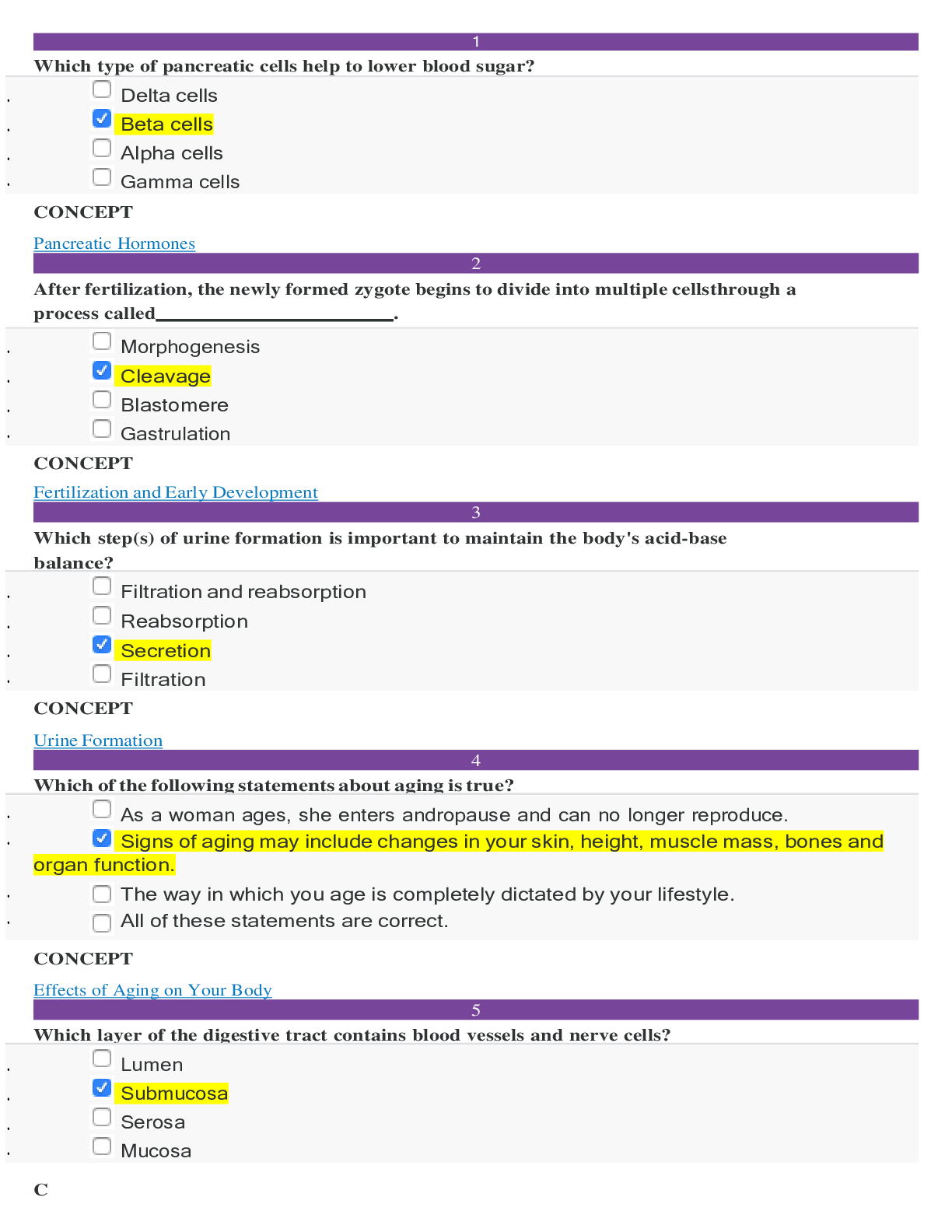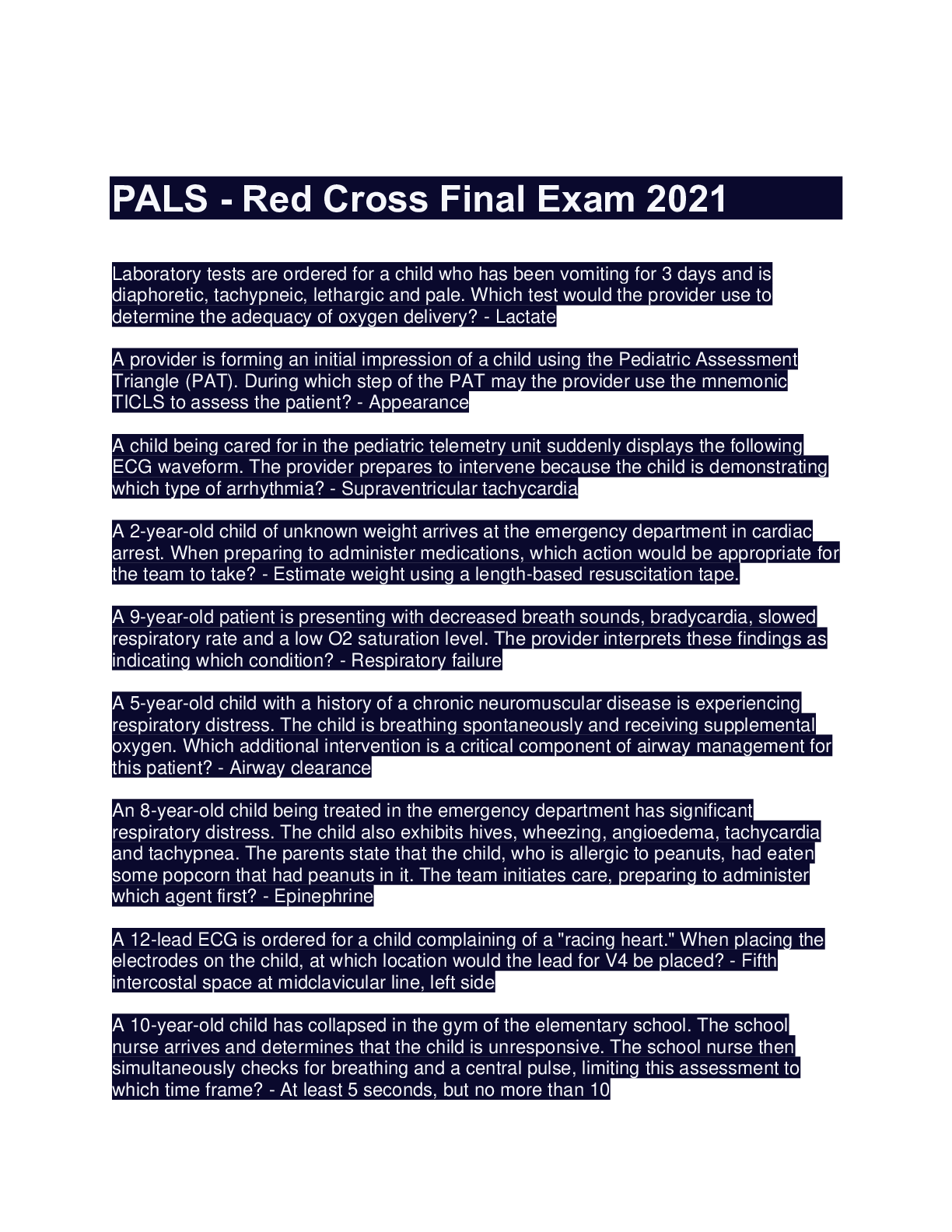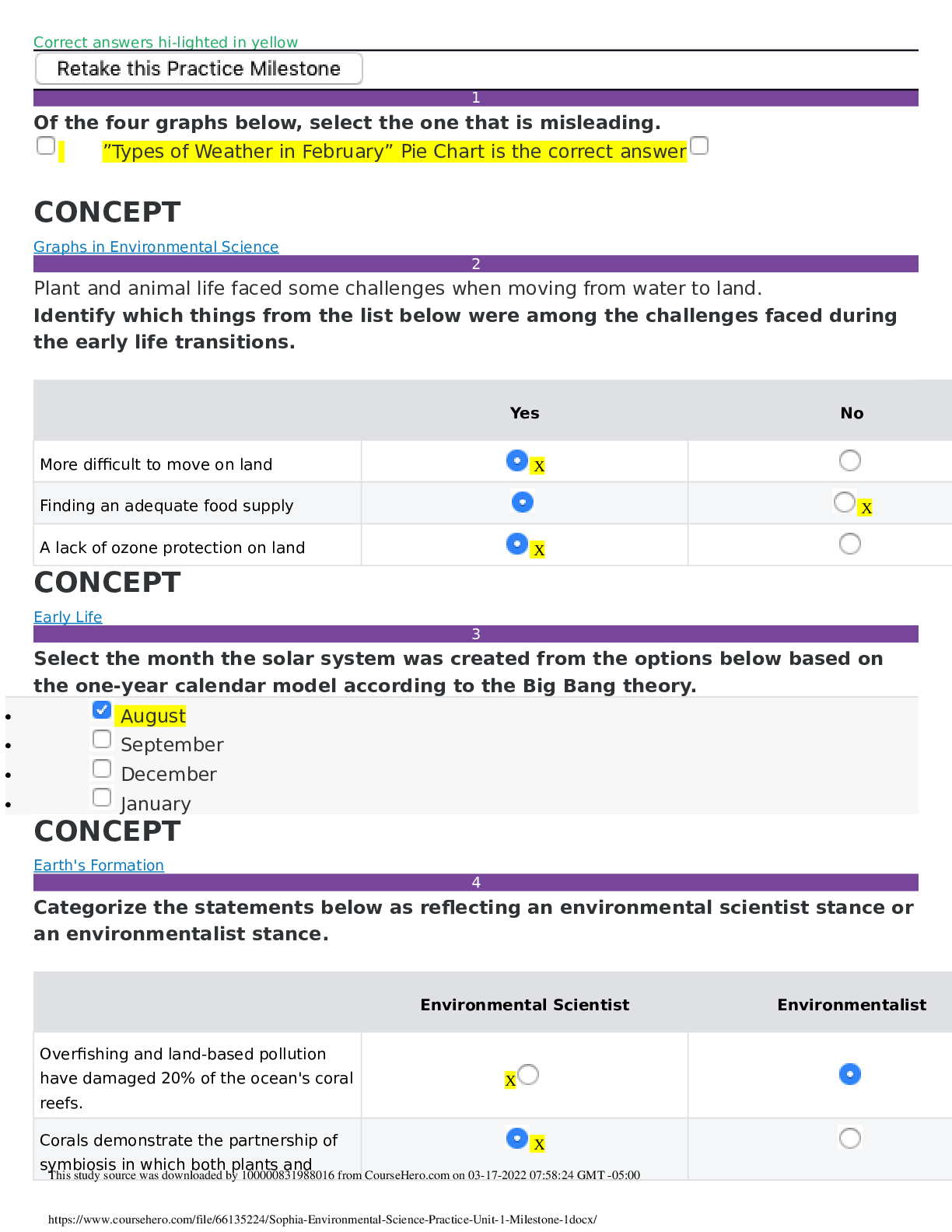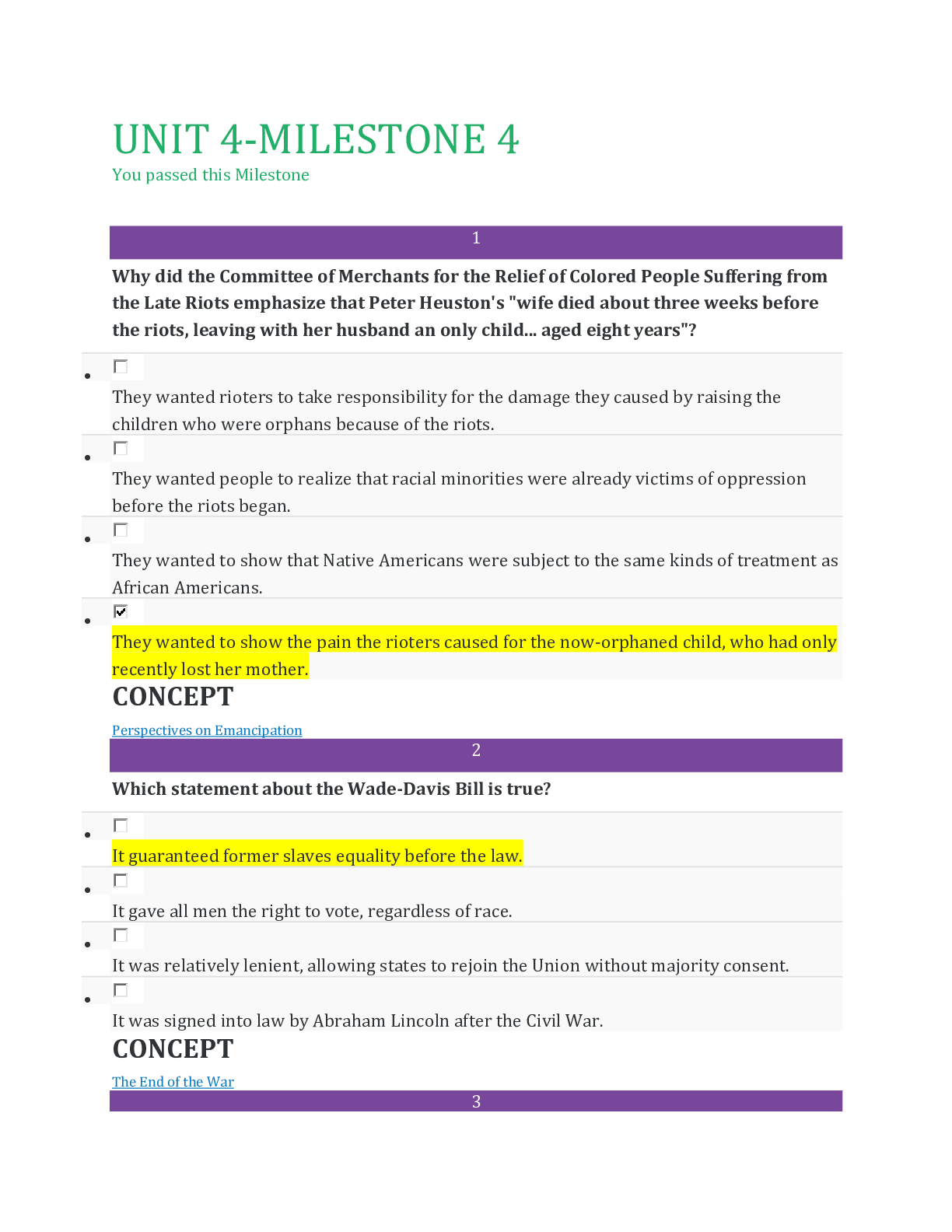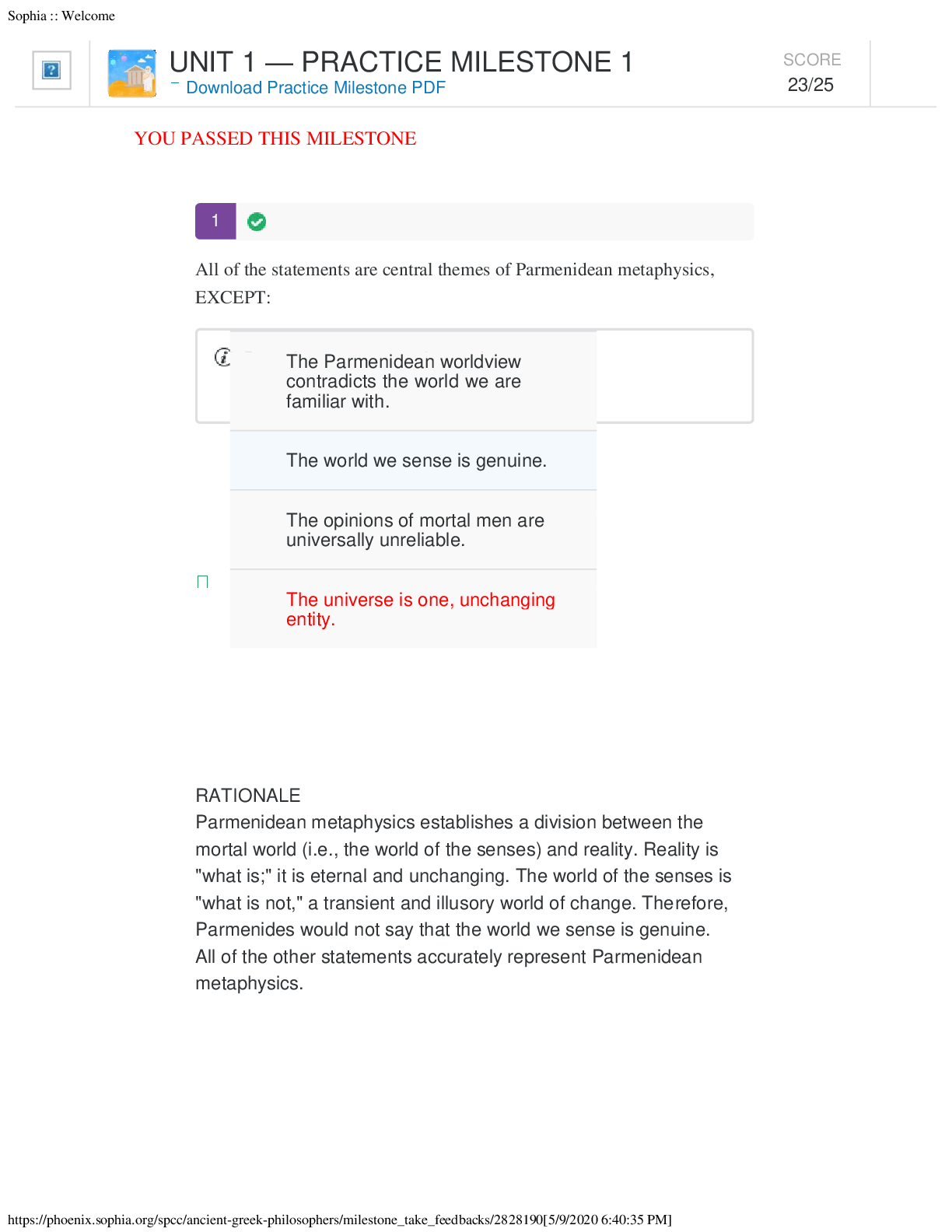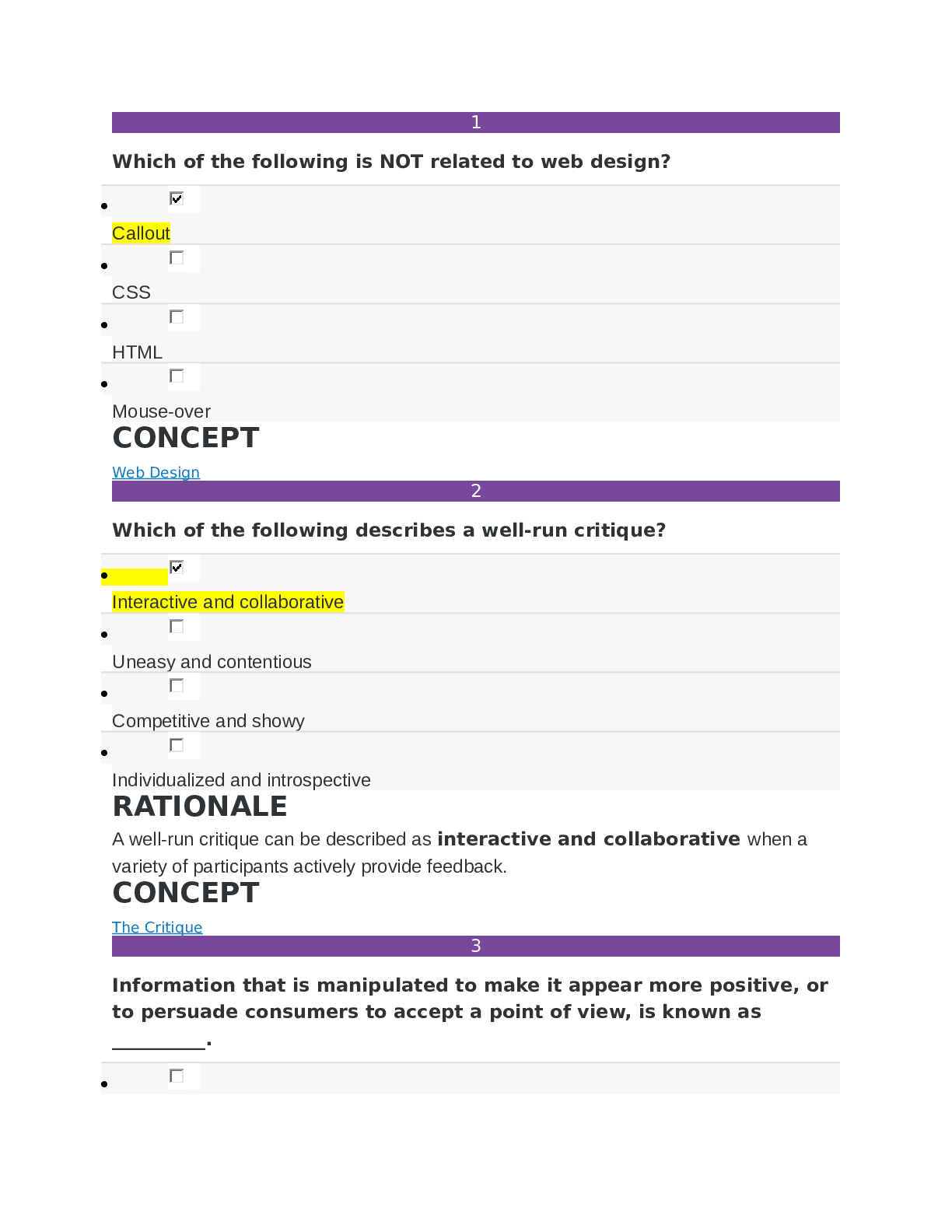Statistics > SOPHIA PATHWAY > T 300 Unit_3_practice_Milestone_3_(2020)_Sophia_Statistics - Sophia University | MAT300 Unit_3_pract (All)
T 300 Unit_3_practice_Milestone_3_(2020)_Sophia_Statistics - Sophia University | MAT300 Unit_3_practice_Milestone_3_(2020)_Sophia_Statistics
Document Content and Description Below
MAT 300 Unit_3_practice_Milestone_3_(2020)_Sophia_Statistics - Sophia University MAT300 Unit_3_practice_Milestone_3_(2020)_Sophia_Statistics 1 CONCEPT Two-Way Tables/Contingency Tables 2 CONCEPT... Conditional Probability and Contingency Tables 3 CONCEPT Poisson Distribution 4 CONCEPT Fundamental Counting Principle 5 CONCEPT Odds 6 CONCEPT Conditional Probability 7 CONCEPT Outcomes and Events 8 A. B. CONCEPT Probability Distribution 9 CONCEPT "And" Probability for Independent Events 10 CONCEPT Relative Frequency Probability/Empirical Method 11 CONCEPT Binomial Distribution 12 CONCEPT "Either/Or" Probability for Non-Overlapping Events 13 CONCEPT Geometric Distribution 14 A. B. C. CONCEPT Normal Distribution Approximation of the Binomial Distribution 15 CONCEPT "Either/Or" Probability for Overlapping Events 16 CONCEPT Independent vs. Dependent Events 17 CONCEPT Conditional Probability 18 CONCEPT "And" Probability for Dependent Events 19 You passed this Practice Milestone. When you take the actual Milestone, you must score 50% or higher to pass. Retake this Practice Milestone 27 questions were answered correctly. A catering company offers three different meals for a large gathering. Based on the RSVPs from 1,200 guests, the meal preferences are listed in the table and broken down by gender. Men Women Chicken 144 252 Seafood 144 228 Beef 276 156 If an RSVP is selected at random, what is the probability that the guest is a man who chose chicken as his meal preference? Answer choices are rounded to the hundredths place. RATIONALE If we want the probability of people who chose "Chicken" and is also a man, we just need to look at the box that is associated with both categories, or 144. To calculate the probability, we can use the following formula: A catering company offers three different meals for a large gathering. Based on the RSVPs from 1,200 guests, the proportions of meal preferences are listed in the table and broken down by gender. Men Women Chicken 0.12 0.21 Seafood 0.12 0.19 Beef 0.23 0.13 Given the guest chosen was a man, the probability that a randomly selected person chose the beef meal is __________. RATIONALE The probability of a guest choosing meat, given they are a man, is a conditional probability. We can use the following formula: Remember, to find the total number of men, we need to add all values in this column: 0.12 + 0.12 + 0.23 = 0.47. The average number of heads that occur when a particular coin is flipped for one minute is eight. What is the probability that five heads are tossed during a particular 1-minute period? RATIONALE Since we are finding the probability of a given number of events happening in a fixed interval when the events occur independently and the average rate of occurrence is known, we can use the following Poisson distribution formula: The variable k is the given number of occurrences, which in this case, is 5 heads. The variable λ is the average rate of event occurrences, which in this case, is 8 heads. Jane is playing a game of Yahtzee. In this game, five standard dice are rolled on the first roll. Then some of the dice may be rolled again on the second roll. What is the total number of possible outcomes for each trial? RATIONALE We can use the general counting principle and note that for each step, we simply multiply all the possibilities at each step to get the total number of outcomes. Each die has 6 possible outcomes, so the overall number of outcomes for rolling 5 die with 6 possible outcomes each is: . Jim is at the racetrack and has bet on his favorite horse. At post time, the odds in favor of his horse winning were 5:7. What is the probability ratio for Jim's horse to win? RATIONALE Recall that we can go from "A:B" odds to a probability by rewriting it as the fraction " ." So odds of 5:7 is equivalent to the following probability: Using the Venn diagram, the probability that event A occurs is __________. The conditional probability of event B occurring, assuming event A has happened [P(B|A)], is __________. RATIONALE The probability that event A occurs is ALL of circle A, or 0.25 + 0.5 = 0.75. To get the probability of B given A has occurred, we can use the following conditional formula: The probability of A and B is the intersection, or overlap, of the Venn diagram, which is 0.5. Serena is at a casino playing the game of craps, where she rolls two standard dice and the numbers are added together. Select three possible outcomes when she rolls the dice. RATIONALE Since she rolls 2 standard dice we know that there are values from 1 to 6 for each die. All the possible outcomes are all the 2 values she might observe on the rolls. The smallest value she might observe is (1,1) and the largest (6,6). So the smallest sum would be 2 (1 + 1) and the largest sum would be 12 (6 + 6). As long as sum values are between 2 and 12, they are possible. Match each distribution to the term that best describes it. Discrete distribution Continuous distribution RATIONALE Recall a discrete distribution is broken up into countable parts, while a continuous distribution can take on any value within an interval. So the distribution with vertical columns (binomial distribution) is discrete, while the bell-shaped distribution that is a continuous line is a continuous distribution. In an experiment, a die is rolled and a coin is tossed. What is the probability of rolling a six and flipping a head? RATIONALE We can assume the roll and flip are independent. To find the probability of 2 independent events, we can use the following formula: When rolling a single die, there is a one out of six chance of landing on six. When tossing a single coin, there is a 1 out of 2 chance of landing on heads. Karen flipped a coin 50 times, and the coin came up heads 28 times. What is the relative frequency of tails in this experiment? RATIONALE Recall that, of the 50 flips, there are 28 heads. This means the remaining are tails, or 50-28 = 22 tails. The relative frequency of tails is: . Which of the following is NOT a condition of the binomial distribution? RATIONALE When we explore the number of trials before first success, this is called a geometric distribution. What is the probability of drawing a queen of hearts or a king of diamonds? RATIONALE Since the two events, drawing a queen of hearts and drawing a king of diamonds, are non-overlapping, we can use the following formula: Suppose a coin is being tossed. Let the random variable X be the number of tosses it will take until the coin lands on heads. Assuming that the tosses are independent, find the probability that it requires six tosses to get heads for the first time. RATIONALE Since we are looking for the probability until the first success, we will use the following Geometric distribution formula: The variable k is the number of trials until the first success, which in this case, is 6 tosses. The variable p is the probability of success, and in this case, a success is considered landing on tails, which is 0.5. Mark looked at the statistics for his favorite baseball player, Joe Mauer. Mark looked at seasons when Mauer played 150 or more games and found that Mauer's probability of hitting a home run in a game is 0.189. Mark uses the normal approximation of the binomial distribution to find the mean, standard deviation, and variance of the number of home runs Mauer is projected to hit in 150 games. Match each term with the correct value. Answer choices are rounded to the hundredths place. 22.99 28.35 4.79 RATIONALE In this situation, we know: n = sample size = 150 p = success probability = 0.189 We can also say that q, or the complement of p, equals: q = 1 - p = 1 - 0.189 = 0.811 The mean is equivalent to n*p: The variance is equivalent to n*p*q: The standard deviation is equivalent to the square root of the variance: Using the Venn diagram provided, what is the probability that event A or event B occurs? RATIONALE To find the probability that event A or event B occurs, we can use the following formula for overlapping events: The probability of event A is ALL of circle A, or 0.32 + 0.12 = 0.44. The probability of event B is ALL of circle B, or 0.27 + 0.12 = 0.39. The probability of event A and B is the intersection of the Venn diagram, or 0.12. We can also simply add up all the parts = 0.32 + 0.12 + 0.27 = 0.71 Jackie is randomly drawing from a deck of 52 cards. She first draws the king of spades, places it back in the deck, shuffles the deck, and then draws another card. This time the card is the seven of hearts. Which of the following statements is NOT true? RATIONALE Since the deck was reshuffled and the card was put back in the deck, we can assume the draws were independent. Since the draws were independent, the probability of drawing a king, before it is actually drawn, would be the same. It doesn't have a lower probability on the second draw due to the shuffling and putting it back into the deck. Zhi went to a blackjack table at the casino. At the table, the dealer has just shuffled a standard deck of 52 cards. Zhi knows that getting 21, or a blackjack, is the best hand possible. She really likes her chances when she is dealt an Ace card first. Zhi wonders what her chances are of getting an Ace if she gets a red card. What is the probability that the card is an Ace, given that it is a red card? Answer choices are in a percentage format, rounded to the nearest whole number. RATIONALE The probability of it being an Ace, given it is a red card uses the conditional formula: Annie was having fun playing poker. She needed the next two cards dealt to be clubs so she could make a flush (five cards of the same suit). There are 14 cards left in the deck, and five are clubs. What is the probability that the two cards dealt to Annie (without replacement) will both be clubs? Answer choices are in percentage format, rounded to the nearest whole number. RATIONALE If there are 14 cards left in the deck with 5 clubs, the probability of being dealt 2 clubs if they are dealt without replacement means that we have dependent events because the outcome of the first card will affect the probability of the second card. We can use the following formula: The probability that the first card is a club would be 5 out of 14, or . The probability that the second card is a club, given that the first card was also a club, would be because we now have only 13 cards remaining and only four of those cards are clubs (since the first card was a club). So we can use these probabilities to find the probability that the two cards will both be clubs: What is the probability of drawing a black card or a face card from a standard deck of 52 cards? RATIONALE Since it is possible for a card to be both a black card and a face card, these two events are overlapping. We can use the following formula: In a standard deck of cards, half of the 52 cards are black, so . There are a total of 12 face cards, so . Of the 12 face cards, 6 are red and 6 are black, so . 0.36 ! 0.12 0.26 0.68 0.360 ! 0.489 0.639 0.230 0.18 ! 0.09 0.07 0.30 36 30 ! 7,776 3,125 ! 0.25; 0.5 ! 0.75; 0.67 0.5; 0.67 0.67; 0.75 ! 10 1 2 ! 0 ! 12 B ! A ! ! ! 0.44 0.56 0.22 0.28 The variable of interest is the total number of successes or failures for a given number of observations. There are a fixed number of observations. The variable of interest is the total number of observations before the ! first success or failure is observed. There is a fixed probability of success or failure for each observation. All of the observations made are independent of each other. ! 0.0312 0.5000 ! 0.0156 0.0625 ! B mean ! C standard deviation ! A variance 0.83 0.12 ! 0.71 0.44 Each draw can be considered an independent event, since Jackie reshuffled the deck. The probability of drawing the king of spades was for both draws. The probability of drawing the king of spades and then the seven of hearts in this scenario is . The probability of drawing the seven of hearts was for both draws. There was a lower probability that the king of spades would be drawn ! the second time, because it was drawn the first time. ! 8% 38% 25% 15% 36% ! 11% 13% 46% ! UNIT 3 — PRACTICE MILESTONE 3 ! Download Practice Milestone PDF SCORE 27/27 https://www.coursehero.com/file/62819770/Unit-3-practice-Milestone-3-Sophia-Statistics-pdf/CONCEPT "Either/Or" Probability for Overlapping Events 20 CONCEPT Overlapping Events 21 CONCEPT Complement of an Event 22 CONCEPT Expected Value 23 CONCEPT Theoretical Probability/A Priori Method 24 CONCEPT False Positives/False Negatives 25 CONCEPT Paradoxes 26 CONCEPT Venn Diagrams 27 CONCEPT Law of Large Numbers/Law of Averages Which of these are overlapping events? RATIONALE Events are overlapping if the two events can both occur in a single trial of a chance experiment. When drawing a Queen {Queen of Hearts, Queen of Clubs, Queen of Diamonds, Queen of Spades} or a red card {any card that is a Diamond or Heart}, the overlap is Queen of Hearts or Queen of Diamonds. What is the probability of NOT drawing a diamond from a standard deck of 52 cards? RATIONALE Recall that the probability of a complement, or the probability of something NOT happening, can be calculated by finding the probability of the event happening, and then subtracting that from 1. Note that there are a total of 13 diamond cards in a standard deck of 52 cards. So the probability of NOT getting a face card is equivalent to: Danielle is playing a game where she selects a card from a deck of four cards, labeled 1 , 2, 3, or 4. The possible cards and probabilities are shown in the probability distribution below. What is the expected value for the card that Danielle selects? RATIONALE The expected value, also called the mean of a probability distribution, is found by adding the products of each individual outcome and its probability. We can use the following formula to calculate the expected value, E(X): A lottery uses a container with 25 identical balls numbered 1 through 25, from which three balls are selected. What is the theoretical probability that the number 13 is picked first? RATIONALE If we suppose that the first ball chosen for the lottery is fixed, then there are 25 possible values, {1, 2, 3, ...., 23, 24, or 25}, that are all equally likely. So, the probability that a specific value is chosen is: Ben is a sheepherder who often likes to play tricks on his employer by claiming that he sees a nearby predator when there is, in fact, no predator around to threaten his flock. This is an example of ________. RATIONALE Since he indicates positively that there is a predator when in fact there is not, this is a false positive. Bailey was trying to decide which type of ice cream topping to restock based on popularity: chocolate fudge or caramel. After studying the data, she noticed that she sold more caramel toppings on weekdays and weekends. However, after combing through her entire sales records, she actually sold more chocolate fudge toppings than caramel toppings. Which paradox had Bailey encountered? RATIONALE This is an example of Simpson's paradox, which is when the trend overall is not the same that is examined in smaller groups. Since the sale of fudge overall is larger but this trend changes when looking at weekend/weekday, this is a reversal of the trend. Two sets A and B are shown in the Venn diagram below. Which statement is NOT true? RATIONALE To get the total number of items in the Venn diagram, we add up what is in A and B and outside, which is 16+3+24+50 = 93 elements, not 96 elements. The number of elements of Set A is everything in Circle A, or 16+3 = 19 elements. The number of elements of Set B is everything in Circle B, or 24+3 = 27 elements. Any number outside of Circle A and B are elements that do not belong to either circle. In this Venn diagram, there are 50 elements that do not belong to either set. Sandy tosses a fair coin multiple times, recording the total number of heads and then calculating the proportion of heads so far after each toss. She then constructs a graph to visualize her results. Which of the following statements is NOT true? RATIONALE The probability distribution is the theoretical distribution that captures how probability should be assigned over different outcomes. It doesn't change as coins are flipped. The results help to illustrate what the underlying probability distribution is. Drawing a face card or a 9 from a standard deck of cards Drawing a Diamond or a Club from a standard deck of cards ! Drawing a red card or a Queen from a standard deck of cards Drawing a Queen of Hearts or a Jack of Spades from a standard deck of cards ! 0.35 0.25 ! 2.7 2.2 ! false negative Benford's Law Simpson's Paradox ! false positive ! Simpson's Paradox False Positive False Negative Benford's Law Set B has 27 elements. ! There are a total of 96 elements shown in the Venn diagram. Set A has 19 elements. 50 elements do not belong either to set A or to set B. The relative frequency of heads flipped changes as Sandy tosses the coin more. This is an example of the Law of Large Numbers. The probability distribution for the possible coin outcomes changes as ! the total number of coin tosses increases. For a given number of tosses, we can use the graph to find the number of tails that have been flipped so far. The theoretical probability is 0.5 for each coin toss to be heads. © 2020 SOPHIA Learning, LLC. SOPHIA is a registered trademark of SOPHIA Learning, LLC. About Contact Us Privacy Policy Terms of Use https://www.coursehero.com/file/62819770/Unit-3-practice-Milestone-3-Sophia-Statistics-pdf/ source was shared via CourseHero.com Powered by TCPDF (www.tcpdf.org) [Show More]
Last updated: 1 year ago
Preview 1 out of pages

Reviews( 0 )
Document information
Connected school, study & course
About the document
Uploaded On
Sep 14, 2020
Number of pages
Written in
Additional information
This document has been written for:
Uploaded
Sep 14, 2020
Downloads
0
Views
18


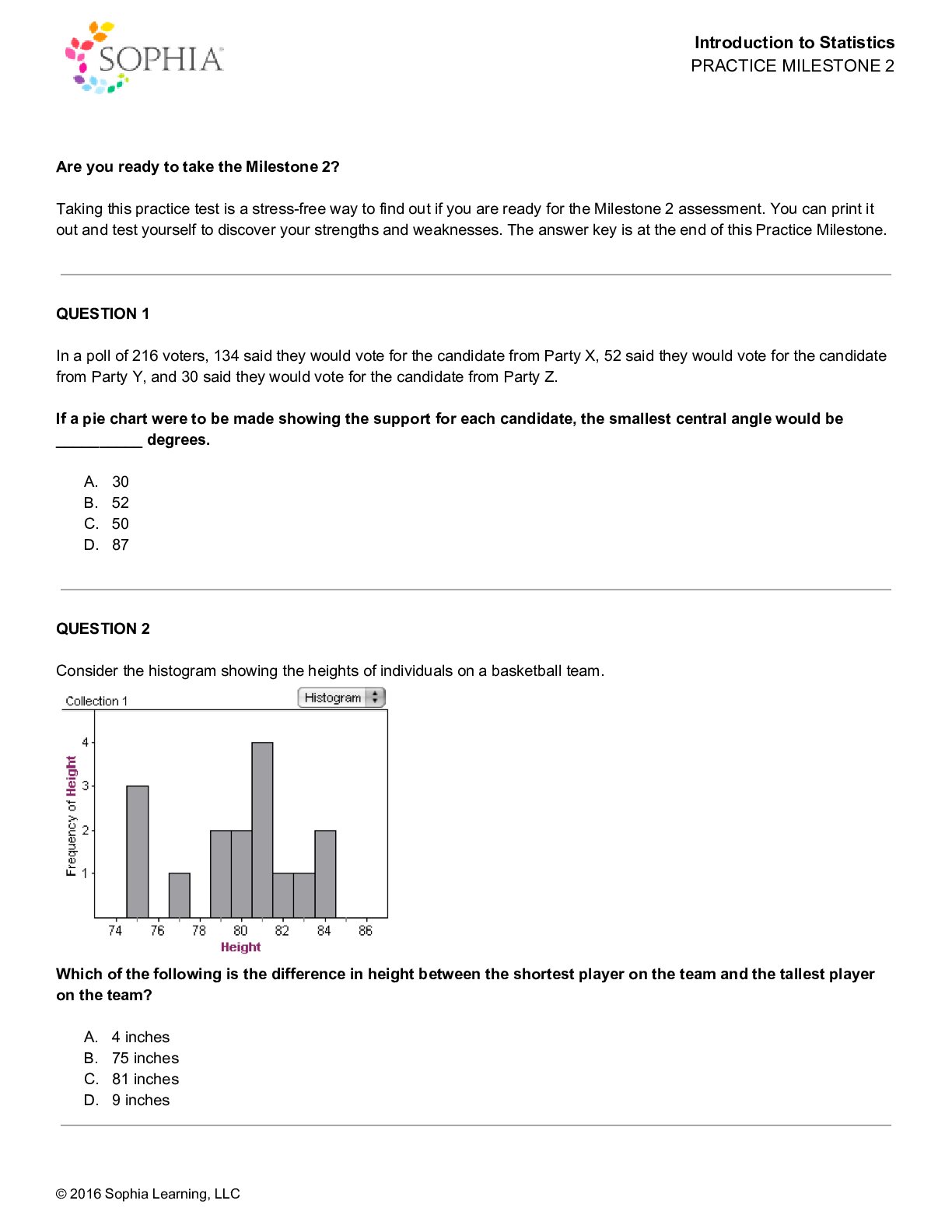
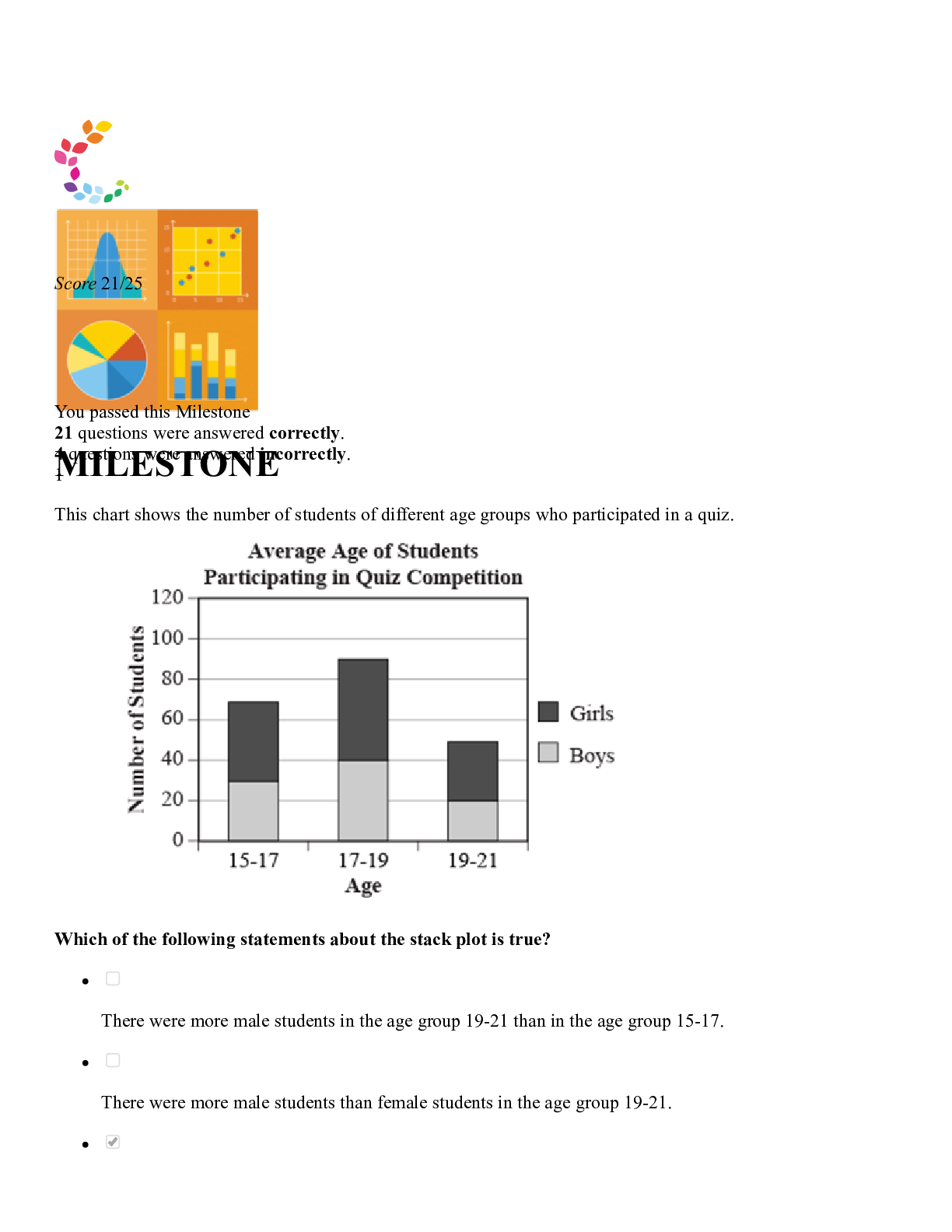

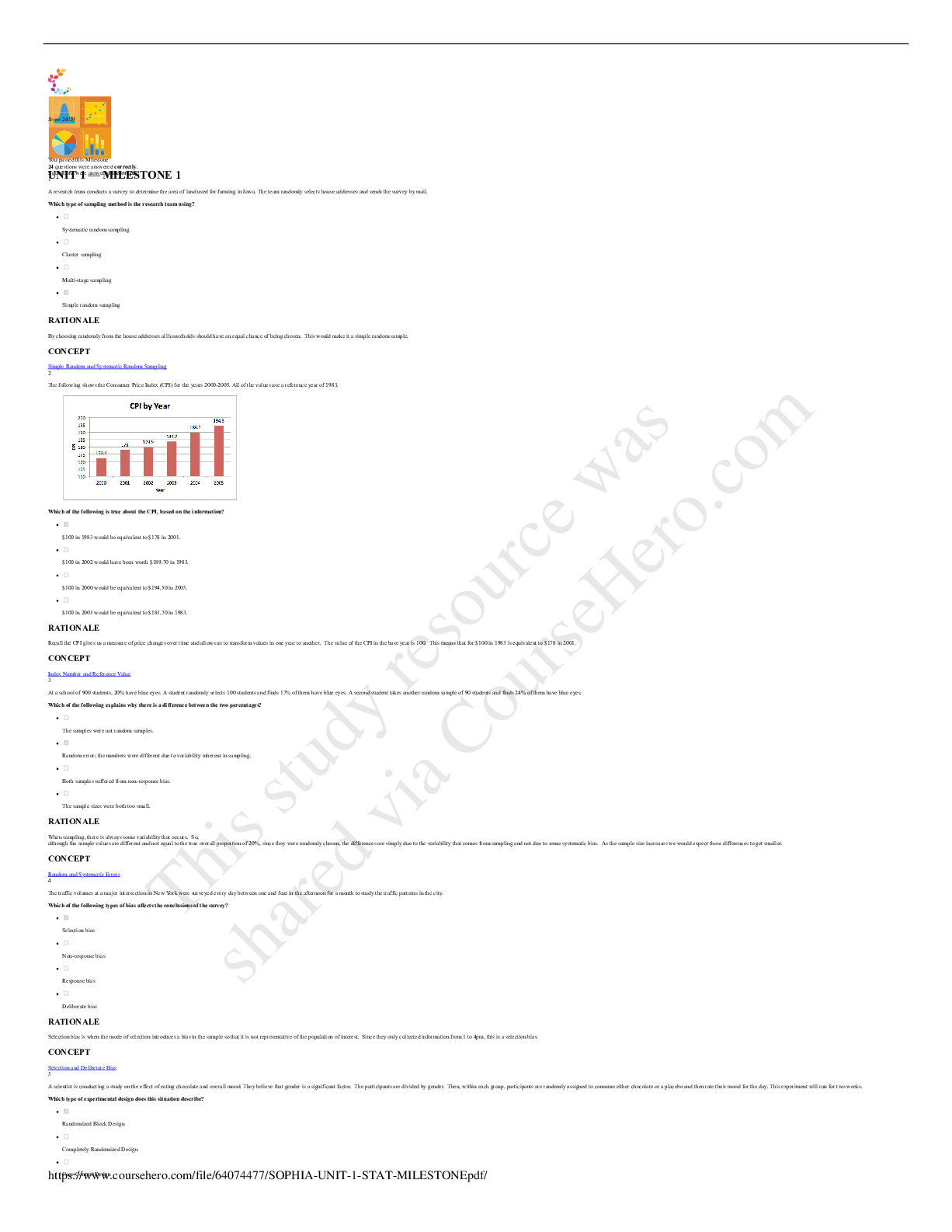
 – University of the People.png)
 – University of Maryland.png)
 – University of the People.png)
 – University of the People.png)
 – University of the People.png)



